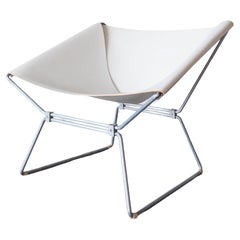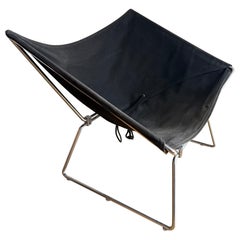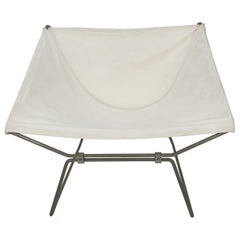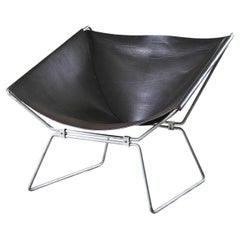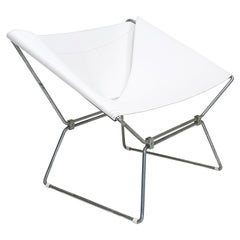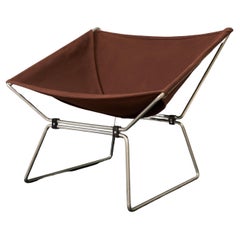Pierre Paulin Anneau
Anneau Chair by Pierre Paulin for A. Polak
By Pierre Paulin
Located in New York, NY
The 'Anneau' Chair, designed by Pierre Paulin for AP Polak (Manufacturer)designed in 1955, features
Category
Vintage 1970s French Mid-Century Modern Lounge Chairs
Materials
Steel
“Anneau” chair by Pierre Paulin, designed in the 1950s and produced by AP Polak
By Pierre Paulin
Located in Copenhagen, DK
Stunning and rare AP-14 “Anneau” chair by Pierre Paulin, designed in the 1950s and produced by AP
Category
Vintage 1950s French Mid-Century Modern Lounge Chairs
Materials
Steel
$3,461
H 27.17 in W 31.89 in D 25.2 in
Pierre Paulin AP-14 "Anneau" Butterfly Chair by AP Polak, 1950's
By Pierre Paulin
Located in Oud Beijerland, NL
This stunning AP-14 "Anneau" chair is designed by Pierre Paulin.
It is manufactured by AP Polak in
Category
Vintage 1950s Dutch Mid-Century Modern Armchairs
Materials
Metal
$4,763
H 26.78 in W 32.29 in D 25.2 in
Anneau Lounge Chair by Pierre Paulin
Located in Conwy, GB
A scarce first edition AP-14 'Anneau' armchair, designed in 1955 by Pierre Paulin, produced by AP
Category
Mid-20th Century French Lounge Chairs
Materials
Leather
Recent Sales
Pierre Paulin AP-14 "Anneau" Butterfly Chair, New White Saddle Leather, AP Polak
By Pierre Paulin
Located in Hitchin, England
A newly upholstered in white saddle leather AP-14 Pierre Paulin "Anneau" chair manufactured by AP
Category
Mid-20th Century Dutch Mid-Century Modern Armchairs
Materials
Steel
H 26.78 in W 31.11 in D 26.78 in
ANNEAU AP-14 LOUNGE CHAIR Pierre Paulin for Polak
By Pierre Paulin
Located in Forest, BE
AP14 lounge chair also known as “Anneau” by Pierre Paulin for Polak. Pierre Paulin was a renowned
Category
Vintage 1950s French Lounge Chairs
Materials
Metal
Anneau Chair by Pierre Paulin for AP Polak (Model Ap-14)
By Pierre Paulin
Located in Long Island City, NY
The 'Anneau' Chair, designed by Pierre Paulin for AP Polak (Manufacturer)designed in 1955, features
Category
Late 20th Century French Lounge Chairs
Materials
Steel
AP14 Lounge Chair “Anneau” by Pierre Paulin for AP Originals 50s
By Pierre Paulin, AP Originals
Located in Landgraaf, NL
AP14 lounge chair also known as “Anneau” by Pierre Paulin for AP Originals (A. Polak) 50’s. Unique
Category
Mid-20th Century Dutch Mid-Century Modern Lounge Chairs
Materials
Metal
Pierre Paulin AP-14 'Anneau' Butterfly Chair with New Saddle Leather, 1950s
By Pierre Paulin
Located in Pijnacker, Zuid-Holland
Very rare AP-14 Butterfly chair by Pierre Paulin for A. Polak in 1955.
Reupholstered in a beautiful
Category
Vintage 1950s Dutch Mid-Century Modern Lounge Chairs
Materials
Chrome
H 25.2 in W 32.29 in D 26.78 in
Sculptural Mid-Century Modern Anneau Lounge Chair by Pierre Paulin, 1955 Polak
By Pierre Paulin
Located in Beek en Donk, NL
Sculptural Mid-Century Modern lounge chair AP 14, designed by Pierre Paulin in 1955 and executed by
Category
Vintage 1950s Dutch Mid-Century Modern Lounge Chairs
Materials
Metal
H 26.78 in W 31.5 in D 25.2 in
People Also Browsed
Guido Faleschini for Mariani Set of Queen Bed Nightstands and Stools in Leather
By i4 Mariani, Guido Faleschini
Located in Waalwijk, NL
Guido Faleschini for Mariani, ‘Pace Collection’ set of queen bed, two nightstands and two stools, leather, chrome-plated brass, enameled steel, Italy, circa 1975
This eccentric set...
Category
Vintage 1970s Italian Mid-Century Modern Bedroom Sets
Materials
Steel, Chrome
$39,700
H 27.56 in W 156.7 in D 86.62 in
Solana Wall Sconces
By Blueprint Lighting
Located in Westport, CT
The "Solana" wall mount sconce or reading light is strongly influenced by Scandinavian, Danish, French, and Italian Mid-Century Modernism. The walnut back plate (available in natural...
Category
21st Century and Contemporary American Mid-Century Modern Wall Lights an...
Materials
Enamel, Brass
Cleopatra Sofa by Geoffrey Harcourt for Artifort, 1970s
By Geoffrey Harcourt, Artifort
Located in Oud Beijerland, NL
This beautiful model Cleopatra chaise longue or sofa was designed by Geoffrey Harcourt for Artifort in the 70's.
This original Artifort piece has just been reupholstered with lov...
Category
Vintage 1970s Dutch Mid-Century Modern Chaise Longues
Materials
Fabric
Coffee Table by Mario Marenco for Mobilgirgi, Italy 1970s
By Mario Marenco
Located in Roma, IT
Coffee Table by Mario Marenco for Mobilgirgi, Italy 1970s.
Cm 32,00 x 87,00 x 87,00.
Walnut Wood.
Good conditions!
Category
Vintage 1970s Italian Coffee and Cocktail Tables
Materials
Walnut
$2,924 Sale Price
30% Off
H 12.6 in W 34.26 in D 34.26 in
LUart Directional Sconce PB by Lumfardo Luminaires
By Lumfardo Luminaires
Located in Los Angeles, CA
LUart Directional Sconce PB is a superbly crafted linear wall sconce designed by Lumfardo Luminaires to feature artwork and/or objets d’art. Each shade is independent and can be dire...
Category
21st Century and Contemporary American Mid-Century Modern Wall Lights an...
Materials
Brass
Pair of Nickel Silver Three Paneled Double Doors
Located in Hanover, MA
SATURDAY SALE
Pair of nickel-silver double entrance doors with three raised square panels, hinges and lock.
Similar to main entrance doors of Tiffany & Co. but origins unknown.
She...
Category
Vintage 1940s Art Deco Doors and Gates
Materials
Stainless Steel, Nickel
$2,200 Sale Price / set
75% Off
H 101 in W 90 in D 2.25 in
Sofa Three-Seat by Jules Leleu, France 1940's - New Upholstery
By Jules Leleu
Located in Brussels, BE
Sofa three-seat by Jules Leleu, France 1940s, new upholstery.
Category
Vintage 1940s French Art Deco Sofas
Materials
Upholstery, Wood
FK 87 Grasshopper Chaise Longue in cognac leather
By Lange Production, Jørgen Kastholm & Preben Fabricius
Located in Copenhagen, DK
FK 87 - 'Grasshopper' easy chair/chaise longue in cognac leather and chrome-plated steel. Designed in 1965. Designed by Preben Fabricius & Jørgen Kastholm, made by Lange Production.
Category
Mid-20th Century Danish Mid-Century Modern Chaise Longues
Materials
Leather
Pair of French Art Deco Side Tables with Etched Glass Tops
Located in Austin, TX
A pair of period French Art Deco low stands (or side tables) of patinated walnut - each table featuring a sleek, early Modern design with three tiers, topped with an inset rectangula...
Category
Early 20th Century French Art Deco Side Tables
Materials
Glass, Wood, Walnut
Chaise Longue Model 242 by Mies van der Rohe for Knoll International
By Knoll, Ludwig Mies van der Rohe
Located in London, GB
The adjustable Model 242 MR Chaise Lounge was designed by Ludwig Mies van der Rohe in 1927.
Produced by Knoll International in the USA, with Brown leather and a chrome steel frame; t...
Category
21st Century and Contemporary American Mid-Century Modern Lounge Chairs
Materials
Chrome
$6,048
H 35.44 in W 26.38 in D 70.87 in
'Tucroma' Leather Bed and Nightstands by Guido Faleschini for i4Mariani, Italy
By i4 Mariani, Guido Faleschini
Located in Los Angeles, CA
This famous 'Tucroma' bed design, as seen in the Lenny Kravitz Architectural Digest magazine photoshoot, was designed by Guido Faleschini in the 1970s and produced by i4Mariani (Ital...
Category
2010s Italian Modern Beds and Bed Frames
Materials
Chrome
$55,000
H 22.5 in W 175.5 in D 87.5 in
Late 19th Century French Painted Iron and Marble Butcher's Table, Bistro Table
Located in Fayetteville, AR
Originally used in a French butcher's shop during the late nineteenth century, this cast iron table features a solid white marble top. Its pale grey painted curved iron legs support ...
Category
Antique Late 19th Century French Patio and Garden Furniture
Materials
Marble, Iron
$1,495
H 28.75 in W 41.25 in D 21.5 in
Bureau vintage Marcello Gacita et Pierre Tiberi pour Rodet verre fumé, plexiglas
Located in BESANÇON, FR
Bureau vintage des années 70, design de Marcello Gacita et Pierre Tiberi pour les éditions Rodet, plateau rectangulaire aux coins arrondis en verre fumé, piétement design en forme de...
Category
Vintage 1970s French Space Age Desks and Writing Tables
Materials
Smoked Glass, Plexiglass
$2,029
H 29.14 in W 55.12 in D 28.35 in
French Designer, Lounge Chairs, Wood, Fabric, France, 1950s
Located in High Point, NC
A pair of wood and green velvet fabric lounge chairs designed and produced in France, c. 1950s.
Overall Dimensions (inches): 33.25"H x 25.625"W x 35.375"D
Seat Height (inches): 17....
Category
Vintage 1950s French Mid-Century Modern Lounge Chairs
Materials
Fabric, Wood
$8,900 / set
H 33.25 in W 25.63 in D 35.38 in
Mid Century Italian Modern Chrome Flat Bar Lounge Chair & Ottoman Set
By Giovanni Offredi
Located in Philadelphia, PA
A very well made lounge chair and ottoman from Italy circa 1970's. It features a solid chrome flatbar frame with tan fabric. The fabric is original so recovering is recommended.
Category
Vintage 1970s Italian Mid-Century Modern Lounge Chairs
Materials
Chrome
On Hold
$3,900 / set
H 31 in W 28 in D 35 in
Original ‘Togo’ 3-seater by Michel Ducaroy for Ligne Roset, France 1960’s.
By Ligne Roset, Michel Ducaroy
Located in Antwerp, BE
A true design classic, this Togo one-seater sofa was designed by Michel Ducaroy for Ligne Roset in the 1960s and remains one of the most recognizable pieces of 20th-century furniture...
Category
Vintage 1960s French Mid-Century Modern Sofas
Materials
Fabric
$4,536 Sale Price
20% Off
H 27.56 in W 68.9 in D 40.16 in
Get Updated with New Arrivals
Save "Pierre Paulin Anneau", and we’ll notify you when there are new listings in this category.
More Ways To Browse
Ap14 Paulin
Antique Three Prong Fork
Antique Washstand Sink
Antique Water Clock
Antique Water Spouts
Antique Wax Jacks
Antique Whiskey Barrels
Antique Whiskey Flask
Antique White Wash Cabinets
Antique Wicker Cart
Antique Wicker Porch Furniture
Antique Willow Chairs
Antique Wood Canoe
Antique Wood Clamps
Antique Wood Corner Shelf
Antique Wood Gear
Antique Wood Rosary
Antique Wooden Drum
